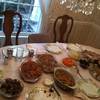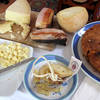"Terre Promesse". Italian Topography at the Calandra Institute
On April 22-24 the John D. Calandra Italian American Institute will host "Terre Promesse: Excursions Towards Italian Topographies", a conference focused on Italian "cultural landscapes" or, in other words, on how Italians and their culture have changed and molded the territory where they settled throughout the world.
The event will see a number of eminent scholars, academics, researchers, and authors facing the issue both on a geographical and historical level, in 14 different sections, and touching it from a social, political, and cultural point of view. The panels, "Travelling Writing", "Points South and West I", "Common Grounds", "Gardening and Harvesting", "Narrated Landscapes", "Sacred Spaces", "Space into Place", "Little Italies", "Re-Mapping Italian America", "Architecture Abandoned, Reclaimed, Re-Imagined", "Creative Spaces ", "Contested Landscapes/Contested Readings", "Land in Literature", "Points South and West II", will all be hosted at the Calandra Institute, the most preeminent research institute on Italian and Italian-American studies on the East Coast.
This is the third year that the Calandra Institute is the focus of the attention of the Italian-American Academic world with a conference that is capable of attracting not only experts in the field from both Italy and the US, but also a wide public of Italian-Americans or lovers of Italy and its culture that find it to be a powerful source of information and knowledge.
The numerous breaks, refreshments, as well as the inauguration dinner offered by the institute and its Dean Prof. Anthony J. Tamburri on April 22 will also become an occasion for the participating speakers to exchange points of view, information and opinions, and possibly to start new research projects and partnerships among Cultural Institutes and Departments of Italian and Italian-American Studies across the country.
Joseph Sciorra, folklorist and Assistant Director for Academic and Cultural Programs at the Calandra, took the time to talk with us about the conference's program, its purposes, and its central importance in the institute's annual calendar of events.
This is the third year that the Calandra Institute organizes and hosts a "mono-thematic" conference of such a breadth. How have things changed from the first edition?
I think that, generally speaking, it is getting better and better every year. Already last year we had a very interesting conference titled "The land of our return", in which we faced themes that are never or very rarely studied on a scholarly level, and it was very successful.
This year we are looking at "cultural landscapes", a theme that is broad enough in its scope but, at the same, is quite specific so that we'll get some very targeted papers. It deals with everything from an imagined landscape to the very practicality of planting a factory, or harvesting tomato plants...
During one of the panels that I will chair, "Gardening and Harvesting" we will also watch two movies on gardening practices. One by Lucia Grillo, "Terra Sogna Terra", and another about Anthony Scotto and Giulia Prestia, a young couple living in the Italian-American neighborhood of Bensonhurst, Brooklyn, named "Memories of Repasts".
For the first time, we will also focus on Italy and its former colonies, such as Eritrea and Ethiopia, since we are adhering to the idea that the notion of Italian topography is so wide that it can include places like Brooklyn and Toronto, just as well as Libya and Eritrea
The scope is not to talk about how many Italians there are in these places, but how Italians interact with the territories they are settled in.
A broad theme that can really interest a wide public...
Yes, last year we had a huge attendance, and we expect the same for this year. This is in spite of the fact that two other important conferences are taking place in this same period. The Hofstra University organized one this past week, while Stony Brook University is having its event on Friday, the first day of our conference. I am troubled by the lack, or the seeming lack, of collegiality of some of my colleagues that seem not to understand that we should cooperate and organize our calendars so that people and scholar's won't find themselves having to choose which event they should attend. It feels like the Italian-American community is still operating as if it's 1953 and everybody is a member of a social club. They are competing against each other, when there should be no competition.
Why did you choose this particular theme this year?
We chose it for two main reasons. First, it is a theme that scholars have been dealing with for some time, since it involves gender, cultural, and historical issues. Second, it's a theme of which I have been writing specifically for a good number of years, looking at Italian-American spaces here in New York City, particularly religious ones.
Besides chairing two panels, you will also present your own paper, "Vernacular Exegesis of the Gentrifying Gaze: Saints, Hipsters, and Public Space in Williamsburg, Brooklyn". What will you talk about?
I look at the neighborhood of Williamsburg in Brooklyn and the ways in which long-term Italian American residents and new Hipsters settling there are interacting in the area of the public-staging of religious processions. My interest is to see how Italians are reacting to these new arrivals.
They feel invaded...
Change is by definition what a city is about, especially in New York's case. The idea of invasion goes back to the 40s, 50s, and 60s, when Anglos felt that New York was being invaded by Italians. So what goes around, comes around...
Today the situation is somehow different, given that this new incoming is mainly caused by the Italian-Americans themselves that choose to rent or sell their houses to the new incomers and go live outside the city, maybe with their children. It's the individual "egoistic reasons" against the general interest that is contributing to the change. Still, this does not detract from the general feeling of loss experienced by the community today.
There are several panel speakers who are obviously non-Italians. Why are they interested in Italian themes and issues?
There is an historical attraction to Italy, but today Italian-Americans themselves are becoming a subject of interest to scholars who are not necessarily Italian. Our history and culture provide information about the ways American society operates on a number of different levels. Pick your subject...
I am reading a book about New York, "Naked City" by Sharon Zukin, that reserches historical and radical culture in the city, labor activism. While in the past, authors of such books would mainly talk about Jews, Anglos, Germans, to provide examples of activism, in this book Italians are the first ethnic group mentioned. You can clearly notice a rising interest toward the history of Italian-Americans.
If you had to give advice to the readers about the conference panels that, in your opinion, they should definitely follow, what would it be?
There are two panels I would never miss. First, the panel I am actually chairing, "Gardening and Harvesting", that features two film screenings and a speech by Patricia Klindienst on Sacco and Vanzetti's gardening. It's a newborn field of study that I find of particular interest, and even if I weren't involved in it, I would without a doubt attend it with the public. Second, "Creative Spaces" with author Tiziana Rinaldi, filmmaker Antonino D'Ambrosio, and Lorenzo Brusci who is coming from Italy. He does marvellous "acoustic gardens", sound environments for which he has became internationally famous, especially in India and Germany.
Two others that look very interesting are "The"Little Italies" one, that will take place on Friday afternoon, with Stefano Luconi, Jerry Krase, and Dana David, and "The Re-Mapping of Italian-America", that will feature contributions by Joseph J. Inguanti, Francesca Canadé Sautman, and Ottorino Cappelli
And finally, of course, one cannot miss the keynote panel with Luisa del Giudice…
Terre Promesse:
Excursions Towards Italian Topographies
April 22–24, 2010
John D. Calandra Italian American Institute
25 West 43rd Street, 17th floor, Manhattan
(between 5 th and 6 th Avenues)
THURSDAY, April 22, 2010
6:30-8:30 pm
WELCOME AND RECEPTION
Anthony Julian Tamburri
John D. Calandra Italian American Institute
Queens College, CUNY
James Muyskens
Queens College, CUNY
Francesco Maria Talò
Consulate General of Italy in New York
FRIDAY, April 23, 2010
9–9:30 AM
Coffee and Pastries
9:30–10:45 AM
CONFERENCE ROOM
Travelling Writing
Chair: Nancy Ziehler, John D. Calandra Italian American Institute
The Dead Sang with Dirt in Their Mouths
Joseph P. Cosco, Old Dominion University
Found in Translation: Symbolic Representations of la madreterra in Literary and Vernacular Writings
Fulvia Masi, Bard College
Click to Enlarge: Connecting Memories, Places, and Cultures in the
Virtual Paese
Robert Oppedisano, Editor/Writer
11–12:15 PM
CONFERENCE ROOM
Points South and West I
Chair: Vincenzo Milione, John D. Calandra Italian American Institute
The Italians of the Jamestown and Virginia Colonies
Giuseppe Di Scipio, Hunter College/CUNY
Here Come the Sicilians: Another Puzzle Piece in the Making of New Orleans
Gerald T. McNeill, Southeastern Louisiana University, and Melissa Puglia McNeill, Stuart Hall School for Boys
The Making of Little Italies in the Appalachian Hill Towns of West Virginia
Victor A. Basile, Independent Scholar
11–12:15 PM
LA GALLERIA
Common Grounds
Chair: Maria LaRusso, John D. Calandra Italian American Institute
Fright or Delight: The Cultural Implications of Wild Fungi as Food
SUSAN M. ROSSI-WILCOX, Independent Scholar
Social Justice and Democracy: The Significance of a Commons
CHRISTINE F. ZINNI, State University of New York at Brockport
12:15–1:30 PM
Lunch on your own
1:30–2:45 PM
CONFERENCE ROOM
Gardening and Harvesting
Chair: Joseph Sciorra, John D. Calandra Italian American Institute
Memories of Repasts (Film)
Karina S. Ramirez, The New School Media Studies Program
Gardens of the Mind: Memory, Ecology, and Justice in the Story of
Tullio Inglese
Patricia Klindienst, Independent Scholar
Terra sogna terra (Film)
LUCIA GRILLO, John D. Calandra Italian American Institute
1:30–2:45 PM
LA GALLERIA
Narrated Landscapes
Chair: Rosangela Briscese, John D. Calandra Italian American Institute
La Brigantessa: The Life of a Female Brigand
Rosanna Micelotta-Battigelli, Author
Mirage
Paola Corso, Western Connecticut State University
U Bizz’ di Creanza: A Piece of Politeness
Joanna Clapps Herman, Manhattanville College
3–4:15 PM
CONFERENCE ROOM
Sacred Spaces
Chair: Dominick Carielli, John D. Calandra Italian American Institute
To Struggle for a Place at the Table: Italian-American Protestants in Italy
Dennis Barone, St. Joseph College
The Role of the Holy Place: Memory and Nostalgia in Italian Jews Who Emigrated in Israel After World War II
Cristina Bettin, Ben Gurion University
Vernacular Exegesis of the Gentrifying Gaze: Saints, Hipsters, and Public Space in Williamsburg, Brooklyn
Joseph Sciorra, John D. Calandra Italian American Institute
3–4:15 PM
LA GALLERIA
Space into Place
Chair: James Periconi, Italian American Writers Association
Tales of a West End Italian Boy
Nicola Battigelli, Author
Performing Nostalgia in Caterina Edwards’ Homeground and Marco Micone’s Deja’ l’agonie
Simone Lomartire, Leeds Metropolitan University
The Place and the Action: The Metaphor of the Square According to the
Social Enterprise
Paola Melone, Institute of the National Research Council
4:30–5:45 PM
CONFERENCE ROOM
Little Italies
Chair: Christine Gambino, John D. Calandra Italian American Institute
Imagined Little Italies
Stefano Luconi, Università degli Studi di Padova
America’s Little Italies as Visually Contested Terrains
Jerry Krase, Brooklyn College/CUNY
Re-Membering the Neighborhood: Creating Community with Food Exchange
Dana David, Pace University
Saturday, April 24, 2010
9–9:30 AM
Coffee and Pastries
9:30–10:45 AM
CONFERENCE ROOM
Re-Mapping Italian America
Chair: Anthony Tamburri, John D. Calandra Italian American Institute
America as Garden of Plenty and Hell on Earth: Pre-and Post-Immigration Images of the Promised Land and their Relation to Italians of the Great Migration
Joseph J. Inguanti, Southern Connecticut State University
From the Nostalgia of Origins to Creating Home: Making Place at the Leonardo da Vinci Art School, New York City, 1923-1940
Francesca Canadé Sautman, Hunter College/CUNY
Italian America: Beyond the Imagined Nation
Ottorino Cappelli, Università degli Studi di Napoli “L’Orientale”
11–12:15 PM
CONFERENCE ROOM
Architecture Abandoned, Reclaimed, Re-Imagined
Chair: Donna M. Chirico, York College/CUNY
Il Borgo Fortificato: Culture, Traditions, Life
John C. Russotto, Independent Scholar, and M. Gabriella Gasbarre,
Italian American Community Club of Rochester
Vernacular Architecture of the Alto Molise
John Caserta, The Design Office
Preserving History in the Old Neighborhood: Saving the Our Lady of Loreto Church, East New York, Brooklyn
Marilyn Ann Verna, St. Francis College, and Mario Toglia, Calitri American Cultural Group
11–12:15 PM
LA GALLERIA
Creative Spaces
Chair: Fabio Girelli-Carasi Brooklyn College/CUNY
Terra, Diana, and Other Buried Voices: Losing the Earth for the Heavens
Tiziana Rinaldi, Author
Terra Promessa (film)
Antonino D’Ambrosio, La Lutta NMC
Architettura Sonora/Applied Acoustics
Lorenzo Brusci, Sound and Experience Design
12:15–1:30 PM
Lunch on your own
1:30–2:45 PM
CONFERENCE ROOM
Contested Landscapes/Contested Readings
Chair: Ottorino Cappelli, Università degli Studi di Napoli “L’Orientale”
Speaking of Place: Campanilismo as Linguistic Practice in Northern Italy
Jillian R. Cavanaugh, Brooklyn College/CUNY
Re-imagining the Colonial Landscape: Notions of Faith, Healing, and Prestige in Goffredo Alessandrini’s Abuna Messias
AnneMarie Tamis, New York University
Segni italiani nelle strade americane
Maddalena Tirabassi, Centro Altreitalie/Globus et Locus
1:30–2:45 PM
LA GALLERIA
Land in Literature
Chair: Fred Gardaphé, Queens College, CUNY
The Transnational Origins of Antonio Stoppani’s Il bel paese
Erica Moretti, Brown University
Paradise from Mud and Stone: Visions of Italy in the Work of Ignazio Silone and Iris Origo
Fred Misurella, East Stroudsburg University
Place and Narrative as Real and Metaphysical Catalysts in Fiction
Gioia Timpanelli, Author
3–4:15 PM
CONFERENCE ROOM
Points South and West II
Chair: Joseph Sciorra, John D. Calandra Italian American Institute
A Northern Southern Italian of the Eastern Western United States:
A Topographical Analysis of John Fante’s Fiction
Jim Cocola, Worcester Polytechnic Institute
Piedmont on the Pacific: Labor, Race, and Place and the Origins of Italian Winemaking in California
Simone Cinotto, University of Gastronomic Sciences
“Il Fuoco di Minonga”: The 1907 Mine Disaster, the Landscape of Coal, and the Making of Transnational Italian Identity in West Virginia
Joan Saverino, The Historical Society of Pennsylvania
4:30–5:45 PM
CONFERENCE ROOM
Closing Keynote
Gastronomic Utopias, Promised Land
Luisa del Giudice, Independent Scholar
All presentations are free and open to the public.
SEATING IS LIMITED
For further information see the Calandra Institute's Website or call (212) 642-2094
The Calandra Institute is a university institute under the aegis of Queens College.





































i-Italy
Facebook
Google+
This work may not be reproduced, in whole or in part, without prior written permission.
Questo lavoro non può essere riprodotto, in tutto o in parte, senza permesso scritto.